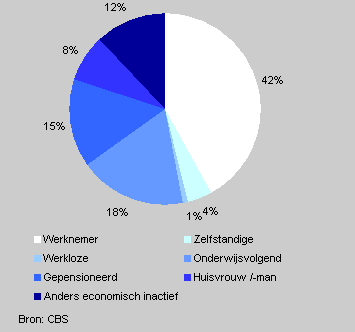The Virtual Census of 2001

Some 30 European countries provided Census data on 2001. A census reviews the state of the population and the social-economic situation. There were none of the special census interviews in the Netherlands, instead Statistics Netherlands combined information from existing data sources. This resulted in a Virtual Census.
Population
Early 2001 there were 16 million inhabitants in the Netherlands: 7.9 million men and 8.1 million women. In the age groups up to 61 there were more men than women, while the reverse was true in the older age groups.
Over 200 thousand people lived in institutional households, such as nursing or care homes. Two thirds of this group consisted of women and over half was aged over 75.
Economic activities
The population of the Netherlands was classified according to economic activity, allowing international comparison. Early 2001 just under half of the population belonged to the economically active population. The employed labour force consisted of 7.4 million people of whom 6.8 million were employees and 600 thousand were self-employed. Everyone working in salaried employment was classified as an employee, even if the person was self-employed on the side. The unemployed labour force, according to international standards, was just under 200 thousand.
Population by economic activity, 1 January 2001

The economically inactive population consists of people in education, pensioners, househusbands and housewives. Someone can only belong to one category. Some with a paid job who is in education belongs to the employed labour force. Some 41 percent of the group ‘otherwise economically inactive’ is under four years old. The number of housewives is over 18 times the number of househusbands.
Outcomes of the Virtual Census
The Virtual Census of 2001 contain data on housing, commuting, occupation, education level, and position on the labour market. In a dozen large municipalities the data are also provided at the neighbourhood level.
The outcomes are the result of combining registers and population surveys conducted by Statistics Netherlands. This working method made the Dutch Census considerably faster and cheaper that those of most other European countries.
Eric Schulte Nordholt